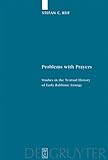Problems with prayers : studies in the textual history of early rabbinic liturgy / by Stefan C. Reif.
Material type: TextSeries: Studia Judaica (Walter de Gruyter & Co.) ; Bd. 37.Publication details: Berlin ; New York : W. de Gruyter, ©2006.Description: 1 online resource (ix, 369 pages) : facsimilesContent type:
TextSeries: Studia Judaica (Walter de Gruyter & Co.) ; Bd. 37.Publication details: Berlin ; New York : W. de Gruyter, ©2006.Description: 1 online resource (ix, 369 pages) : facsimilesContent type: - 9783110895384
- 3110895382
- 3110190915
- 9783110190915
- 296.45 22
- BM660 .R454 2006eb
- online - EBSCO
- BD 1250
| Item type | Current library | Call number | URL | Status | Notes | Barcode | |
|---|---|---|---|---|---|---|---|
 eBook
eBook
|
Biblioteca "Angelicum" Pont. Univ. S.Tommaso d'Aquino Nuvola online | online - EBSCO (Browse shelf(Opens below)) | Online access | Not for loan (Accesso limitato) | Accesso per gli utenti autorizzati / Access for authorized users | (ebsco)558216 |
12 of 18 contributions were published previously.
Includes bibliographical references and indexes.
Preface -- 1. Introduction -- 2. Liturgy in the Second Temple Period: Methodology -- 3. Qumran Research and Rabbinic Liturgy -- 4. Prayer in Ben Sira, Qumran and Second Temple Judaism -- 5. Use of the Bible -- 5. Priesthood in Early Sources -- 6. The Theological Significance of the Shema� -- 7. Jerusalem -- 8. Notions of Restoration -- 9. Approaches to Sacrifices -- 10 From Codex to LaTeX: The Physical Transmission -- 11. Maimonides on the Prayers -- 12. Modern Study of Medieval Liturgy -- 13. Solomon Luria�s Prayer-book
15. ‚Truth and faith� in Genizah Manuscripts16. ‚Al Ha-Nissim�: Its Emergence and Textual Evolution -- 17. A Weil-Known Hymn in Aramaic Guise -- 18. A Genizah Fragment of Grace After Meals -- Indexes -- Sources -- Prayers -- Names -- Subjects -- Plates of Genizah Fragments at Cambridge University Library
Annotation Much of the primary research summarized here relates to Cambridge Genizah manuscripts, a thousand-year-old source that testifies to liturgical (as well, of course, as non-liturgical) developments that greatly predate other source material. When the research is concerned with pre-Genizah history, the Genizah evidence is also relevant since the historian of religious ideas must ultimately decide how to date, characterize, and conceptualize its contents and how to explain where they vary significantly from what became, or is regarded (rightly or wrongly) as having become, the standard rabbinic liturgy sanctioned by the Iraqi Jewish authorities from the ninth to the eleventh century.


